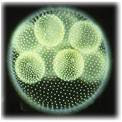 |  |
|
 |  |
|
 |  |
|
 |  |
|
 |  |
|
Hi,
I will never forget what I saw in a drop of pond water under the microscope.
I would like to share the wonder with you here.
Which of the above carry out photosynthesis (=producers), which eat other organisms (=consumers), which are decomposers (=feed on dead organisms)?
Producers use sunlight to make glucose. Glucose is then changed by metabolic processes into other complex organic molecules such as cellulose, starch, proteins, fats and others.These are in turn used for energy release and growth and reproduction.
Producers also release oxygen into the water. Oxygen dissolves into water and allows all aquatic organisms to carry out respiration.
Phytoplankton (=microscopic green plants/algae) are the start of all food chains in the oceans, small and large water bodies.
Phytoplankton is eaten by the slightly larger zooplanktons (=microscopic animals). Can you name some from the from the videos?
Here are the videos:
Can you match the list of names with the organisms that you saw in the videos?
amoeba, desmids, diatoms, Paramecium, vorticella, rotifer, daphnia/water flea, volvox, tardigrade/water bear, hydra, bacteria, spirogyra
Divide the list into producers and consumers.
Divide the list into unicellular and multicellular organisms.
Q: Why is it that many of the organisms have fuzzy/blur outlines?
A: the edges of the organisms are lined with tiny cilia which beat at high speed to draw tiny food particles for the organism to feed on. This gives the blurring effect.
Cheers
Postscript:
Here is my musical answer to the last video above — a few clips set to the "Minute Waltz" (appropriately pronounced 'my-NYOOT', 'not MIN-nut') by Chopin. Enjoy.




testing comment
ReplyDeleteHp Android Sony Ericsson Harga dibawah 2 Juta
ReplyDeleteHP Android Sony Ericsson
Hp Android Sony Ericsson Live With Walkman
HP Android Sony Ericsson Live
Hp Sony Android 1,5 Juta
Harga HP Sony Android 1,5 Juta
Hp Android Smartfren Terbaru 2015
HP Android Smartfren Terbaru
Hp Android Smartfren Terbaru Dual Slim
HP Android Smartfren
Harga HP Android Smartfren Terbaru
Android Smartfren Terbaru
Harga HP Android Smartfren Terbaru 2015
Android Smartfren Terbaru 2015
Obat sakit Gigi